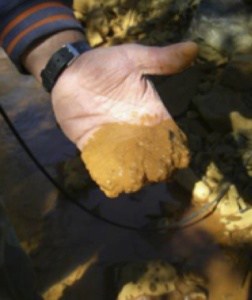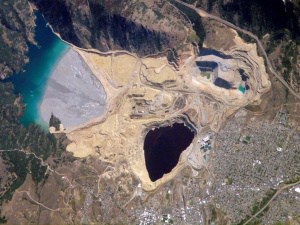
When: July 6 – 31, 2015
Where: Whitman College (Walla Walla, WA); Kellogg, ID; Salmon, ID; Butte, MT
Who: Bryn E. Kimball (Whitman College) and three students
Project Overview and Goals: Trace metals (e.g., Mn, Co, Cu, Zn) are micronutrients for most organisms, but can be toxic above certain threshold concentrations. Trace metal bioaccessibility in aquatic environments is partly controlled by interaction with secondary minerals, and may involve both sorption-desorption and coprecipitation-dissolution reactions. During coprecipitation, trace metals may substitute into crystallographic sites, and may therefore be called trace metal substituted (TMS) secondary minerals. Many studies have focused on trace metal sorption-desorption, whereas relatively fewer studies have documented trace metal coprecipitation-dissolution. To elucidate how TMS secondary minerals control trace metal bioaccessibility, we will: (1) document trace metal substitution in and dissolution from synthesized schwertmannite (Swt), jarosite (Jr), and goethite (Gt); (2) compare and contrast the mineralogy, morphology, and chemical composition of natural ocherous precipitates to synthesized minerals; and (3) use thermodynamic modeling (PHREEQC) of lab and field leach solutions to elucidate aqueous interaction with the secondary minerals present.
Geologic Background: The environments that are particularly prone to formation of TMS secondary minerals are those containing acidic, iron- and sulfate-rich solutions that result from weathering of sulfide minerals. The variety of secondary minerals that form in such environments is vast, but a majority of them contain O2- ± OH– or SO42- ± OH– as the major anion(s) and Fe2+ and/or Fe3+ as the major cation(s), with or without K+ or Na+. Partly because of their relative abundance in stream and river sediments and soils, classic examples include: schwertmannite [Swt; Fe8O8(SO4)2(OH)6], jarosite [Jr; (K+,Na+,H3O+)Fe3(SO4)2(OH)6], and goethite [Gt; α-FeO(OH)]. Trace metal(loid)s may substitute for Fe3+ in octahedral sites (Swt, Jr, Gt), for K+ in highly coordinated sites (CN ≥ 9; Jr), and for sulfur in tetrahedral sites (Swt, Jr). For example, when Cu2+ substitutes for Fe3+ in jarosite, charge balance is maintained by coupling this substitution with Pb2+ substitution for K+ (Hudson-Edwards et al., 2008). Likewise, phosphorus (P) or arsenic (As) may substitute for sulfur in jarosite (e.g., Burger et al., 2009; Desborough et al., 2010; Dutrizac and Chen, 2010). Interestingly, As substitution into synthetic jarosite increases dissolution rates in open systems and decreases dissolution rates in closed systems (Kendall et al., 2013). The potential for TMS in secondary Fe (oxy)hydroxide minerals will directly impact the bioaccessibility of a given metal(oid).
Potential Student Projects: Students may synthesize pure and cobalt (Co)-substituted secondary minerals, and conduct parallel leach experiments with both types of synthetic samples. Synthesized solids will be characterized with X-ray diffraction (XRD) and scanning electron microscopy paired with energy dispersive spectroscopy (SEM-EDS). Solutions generated during simple leaching experiments will be analyzed for pH and conductivity, and solution chemistry will be measured using inductively coupled plasma mass spectrometry (ICP-MS). Each student may also collect Fe (oxyhyr)oxide precipitates and water samples from a field site near Cobalt, ID, and characterize these precipitates (XRD, SEM-EDS) and solutions (pH, conductivity, ICP-MS) upon return to Whitman. Students may then use the thermodynamic modeling program PHREEQC to analyze the solution chemistry results from their lab and field solutions. Students can also compare their leaching results to published leaching results for natural samples and/or their mineral. Thermodynamic modeling and comparing multiple leach studies can be done after the 4-week project at students’ respective home institutions.
Working Conditions: Students should be prepared for demanding, full days in the laboratory. Evenings will be mostly free and of the six weekend days, three will be free and three will be working. Six days will be spent visiting field sites. During this time we will be camping and doing moderate hiking in mountainous terrain. Weather will likely range from hot and sunny to cold with rain/snow. Recommended equipment includes: hiking clothes, rain gear, clothes for warmth, hiking shoes, camping gear (this can be rented), and any other items for health and safety. Examples of possibly stressful situations that may be encountered include:
- strenuous hiking/steep terrain
- significant elevation
- significant risk of sunburn without proper protection
- lack of electricity, refrigeration, and possibly running water while camping
- the possibility of interaction with dangerous insects and/or animals
- limited opportunity for communication with friends/family
- remote field locations, moderately removed from populated areas
Recommended Courses/Prerequisites: Introductory geology (essential), mineralogy (essential), geochemistry (non-essential)
Contact Information
Email: kimballb@whitman.edu
Phone: (509) 527-4951

